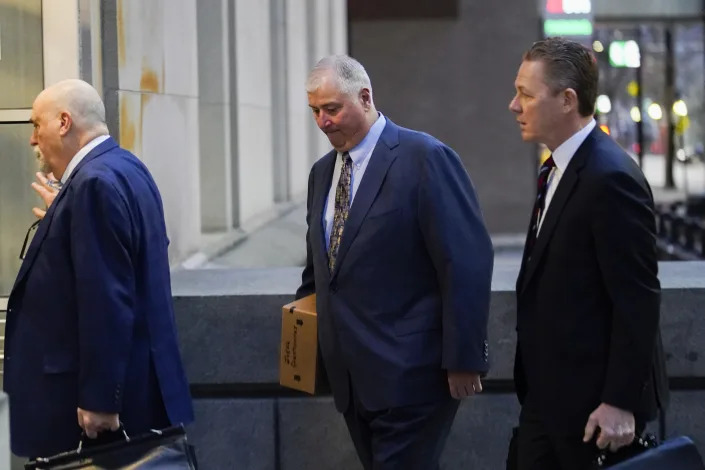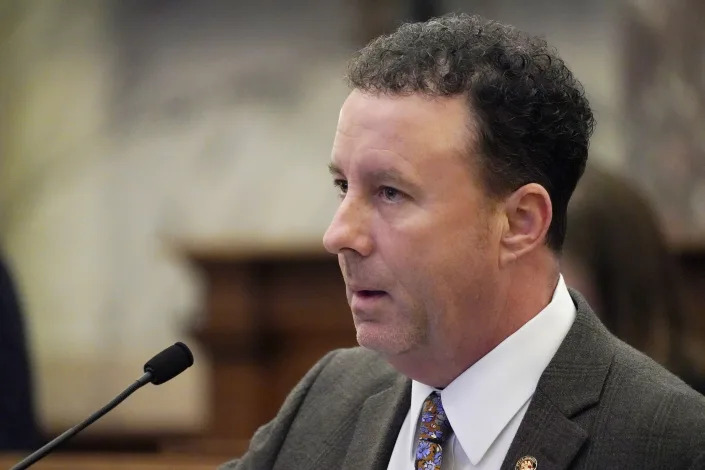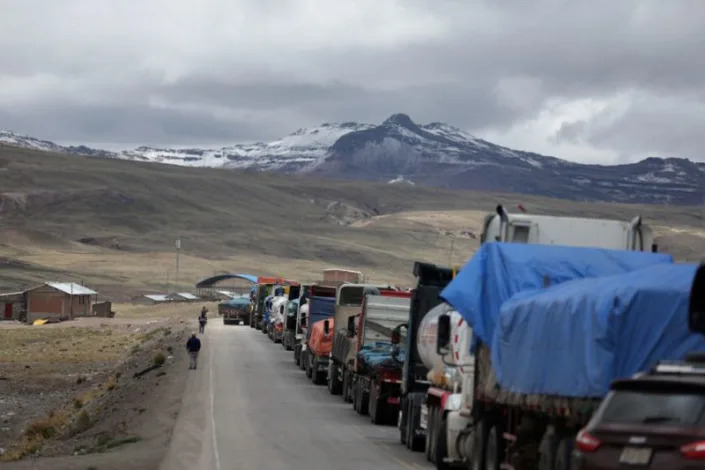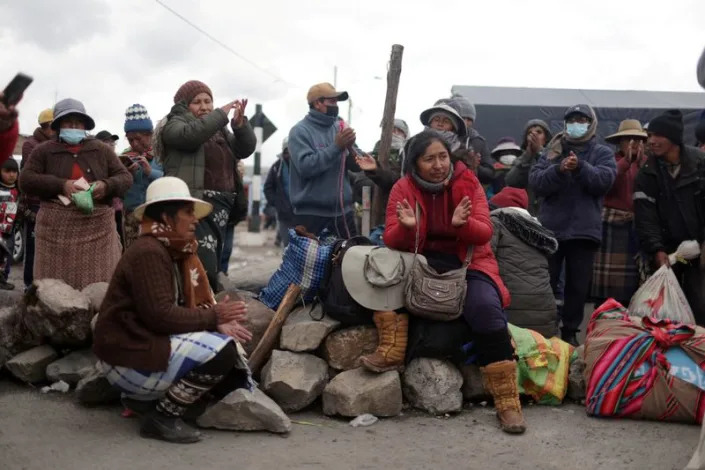Ex-GOP Ohio speaker, lobbyist guilty in $60M bribery scheme


Former Ohio Republican Party Chairman Matt Borges, right, walks toward Potter Stewart U.S. Courthouse with his attorneys Todd Long, left, and Karl Schneider, center, before jury selection in his federal trial, Jan. 20, 2023, in Cincinnati, Ohio. Borges and former state House Speaker Larry Householder were convicted Thursday, March 9, 2023, in a $60 million bribery scheme that federal prosecutors have called the largest corruption case in state history. (AP Photo/Joshua A. Bickel, File)
JULIE CARR SMYTH
Thu, March 9,
COLUMBUS, Ohio (AP) — Ohio House Speaker Larry Householder and former state Republican Party Chair Matt Borges were convicted Thursday in a $60 million bribery scheme that federal prosecutors have called the largest corruption case in state history.
A jury in Cincinnati found the two guilty of conspiracy to participate in a racketeering enterprise involving bribery and money laundering. Each faces up to 20 years in prison.
The government’s prosecution team was able to show that “Householder sold the Statehouse" and betrayed the people he was elected to serve, and that Borges was “a willing co-conspirator,” U.S. Attorney for the Southern District of Ohio Kenneth Parker said in a statement.
“Through its verdict today, the jury reaffirmed that the illegal acts committed by both men will not be tolerated and that they should be held accountable,” Parker said.
The man who brought the case, Parker's predecessor David DeVillers, tweeted: “The line between influence peddling and bribery will now be drawn by the rule of law and not by politicians, lobbyists and corporations."
“We are incredibly disappointed in the verdict,” Householder's attorney Steven Bradley said in an email. “We will take some time to evaluate all of our legal options and will most certainly pursue an appeal. Our client is looking forward to going home to be with his wife and family during this very difficult time.”
The attorney representing Borges, 50, did not immediately respond to messages left by The Associated Press on Thursday. The verdict comes two-and-a-half years after Borges, Householder and three others were arrested.
Prosecutors alleged that Householder, 63, orchestrated a scheme secretly funded by FirstEnergy Corp. to secure his power in the Legislature, elect his allies — and then to pass and defend legislation that delivered a $1 billion nuclear power plant bailout to the Akron-based electric utility. They alleged that Borges, then a lobbyist, sought to bribe Tyler Fehrman, an operative, for inside information on the referendum to overturn the bailout law.
“Justice,” Fehrman, tweeted after the verdicts came down.
In a phone interview, Fehrman said that the outcome proved the risk he took wearing a wire for the FBI as part of the government’s investigation was worth it.
“For them to come back and find both of them guilty, and after not too long, is just such a relief,” he said. “It is a good day for Ohioans. This stuff just can’t continue to happen.”
Householder had been one of Ohio’s most powerful politicians — an historically twice-elected speaker before his indictment. After his arrest, the Republican-controlled House ousted him from his leadership post, but he refused to resign for months on grounds he was innocent until proven guilty. In a bipartisan vote, representatives ultimately ousted him from the chamber, the first such expulsion in Ohio in 150 years.
In a move that may have been pivotal in the trial's outcome, Householder took the stand in his own defense. Appearing confident and relaxed, he spent a day contradicting FBI testimony, defending his support for the bailout bill — known as House Bill 6 — and denying that he attended swanky Washington dinners where prosecutors alleged he and FirstEnergy executives hatched the scheme in 2017. But prosecutors eviscerated his claims on cross-examination the next day.
Rachael Belz, CEO of the government watchdog group Ohio Citizen Action, said she hopes that the trial and guilty verdicts turn the tide in Ohio politics.
“We don’t believe that utilities funneling millions of dollars through shell corporations to drive state policy is how our state government should work, nor do Ohio voters,” she said in a statement. Belz held the decision up as evidence that Ohioans expect and deserve better.
“After so many years of utility-controlled energy policy that favored fossil fuels, Ohio must now move toward equitable, forward-looking solutions that will protect our air and water, the health of Ohioans, and provide clean energy jobs to keep Ohio competitive in the 21st-century economy,” Belz said.
Borges did not testify at trial but has insisted that he’s innocent. His attorneys argued that he was entirely uninvolved with the pay-to-play scheme, while Householder's team portrayed his actions as nothing more than hardball politics.
“The bottom line is that Larry Householder was engaged in political activity, not criminal activity,” his attorney Steven Bradley told jurors during closing statements. He said the government's investigation was flimsy and full of holes, calling it “a nothing burger.”
But over the previous six weeks, jurors had been presented with firsthand accounts of the alleged scheme, as well as reams of financial documents, emails, texts and wire-tap audio.
The prosecution called two of the people arrested — Juan Cespedes and Jeff Longstreth — to testify about political contributions that they said are not ordinary, but bribes intended to secure passage of the bailout legislation.
Householder’s attorneys pushed back on arguments about their recollections, as well as their motivations. Both have pleaded guilty and are cooperating in hopes of a deal with the government.
Jurors also heard taped phone calls in which Householder and another co-defendant, the late Statehouse superlobbyist Neil Clark, plotted a nasty attack ad — and, in expletive-laced fashion, contemplated revenge against lawmakers who had crossed Householder.
Clark, who died by suicide in March 2021, was also heard describing to undercover FBI agents posing as developers how he was directing cash through Generation Now, a dark money group that has also pleaded guilty, to keep it secret.
Householder testified that he never retaliated against those who voted counter to his wishes or who donated to his rivals. He told jurors that the set-up advanced his interests, which were the same as Ohio's interests, because they involved good policy.
Under a deal to avoid prosecution, FirstEnergy admitted using a network of dark money groups to fund the bribery scheme and even bribing the state’s top utility regulator, Sam Randazzo.
Randazzo resigned as chair of the Public Utilities Commission of Ohio after an FBI search of his home, but he has not been charged and denies wrongdoing. The government has asked the PUCO to delay its own internal investigation into FirstEnergy while their probe continues.
Ex-Ohio House Speaker Larry Householder, former Ohio GOP leader Matt Borges found guilty
Laura A. Bischoff and Jessie Balmert, The Columbus Dispatch
Thu, March 9, 2023
A federal jury found both former Ohio House Speaker Larry Householder and ex-Ohio Republican Party chairman Matt Borges guilty of racketeering conspiracy Thursday – a dramatic outcome in the biggest public corruption case in state history.
PODCAST:Former Ohio House Speaker Larry Householder found guilty
The guilty verdict marks the end of Householder’s long political career in which he twice held the speaker’s gavel. He’ll be in the Ohio history books as the only speaker expelled from the Legislature and then convicted in a federal corruption case.
Householder and Borges, who neither showed any emotion when the verdict was read aloud, face up to 20 years in prison. After a seven-week trial, jurors deliberated just nine hours over two days.
The case made it to federal court because of its sweeping scope: $61 million in bribe money paid by FirstEnergy Corp. via dark money groups to help Householder seize political power and in turn pass and defend a $1.3 billion bailout law known as House Bill 6.
Reaction:What Ohio politicians are saying about convictions of Larry Householder, Matt Borges
“This isn’t typical political activity, and they know it,” Assistant U.S. Attorney Megan Painter said during closing statements at the Potter Stewart U.S. Courthouse in Cincinnati. “Mr. Householder abused that (public) trust and Mr. Borges helped him do it.”
After the verdict, U.S. Attorney Kenneth Parker said that the case shows that even powerful state leaders will be held accountable. "You cannot sell the public trust. It is not for sale."
"This is a big win for all Ohioans," Parker said. He declined to answer questions about whether there may be more indictments.

Former Ohio House Speaker Larry Householder is surrounded by the media outside the Potter Stewart U.S. Courthouse in downtown Cincinnati March 9, 2023 after a jury found him and ex-Ohio Republican Party chairman Matt Borges guilty of racketeering conspiracy .
Borges lobbied for the House Bill 6 and worked to block a referendum to put it on the ballot in 2019. He paid a $15,000 bribe to get insider information on the referendum.
More:On the witness stand, Householder spars with federal prosecutor
Borges, who had an ethics conviction expunged more than a decade ago, declined a chance to sign a guilty plea that could’ve given him no more than six months in prison. Borges said after the verdict that he did not regret that choice.
"I don't believe I would have been telling the truth (by pleading)," Borges said. Householder was never given such an offer.

Former Ohio House Speaker Larry Householder, left, heads into the Potter Stewart U.S. Courthouse in downtown Cincinnati Thursday.
Prosecutors introduced nearly 900 exhibits into evidence and slogged through volumes of text messages, emails, bank records and more than demonstrated what the men knew and actions they took.
More:Prosecutor says Householder led pay-to-play scheme; defense calls it 'nothing burger'
Two key players, Former FirstEnergy Solutions lobbyist Juan Cespedes and Householder’s political adviser Jeff Longstreth, took plea deals and testified against them. A fifth defendant, lobbyist Neil Clark, died by suicide in March 2021 after his arrest.
Prosecutors also played secretly recorded phone calls and meetings captured by the FBI. Clark came on their radar while investigating a separate corruption case. Later, undercover agents posing as real estate developers with an interest in sports betting hired Clark as their lobbyist. Clark led them to Householder.
Investigators tapped Clark’s phone but did not do a wiretap on Householder or Borges’ phones.
Another big break came when Tyler Fehrman called the FBI in 2019 to report that Borges offered him a bribe in exchange for insider intel on the referendum campaign. Fehrman, who considered Borges a friend and mentor, wore a wire in subsequent meetings with him.

Former Ohio Republican Party chairman Matt Borges speaks to the media outside of the Potter Stewart U.S. Courthouse in downtown Cincinnati Thursday, March 9, 2023 after a jury found him and Former Ohio House Speaker Larry Householder guilty of racketeering conspiracy.
Householder took the stand in his own defense
When Householder showed up for the first day of trial, he held a press gaggle, telling statehouse reporters that the truth would come out. It was like he had never put down the speaker’s gavel.
Six weeks into the trial, he got a chance to have his say when he took the stand in his own defense.
Householder, 63, of Glenford in Perry County, said he returned to politics to try to quell divisiveness, he had no control over the dark money group Generation Now, didn’t attend key events with FirstEnergy executives and had every intention of paying back Longstreth for a “loan.”
More: Ex-Ohio House Speaker Larry Householder says he didn't trade bailout for campaign cash
The next day he endured a skilled cross examination by Assistant U.S. Attorney Emily Glatfelter in which she dismantled many of his claims.
Borges, 50, of Bexley in Franklin County, opted against taking the stand and did not present any defense witnesses. Instead, his legal team tried to draw jurors’ attention to times when Borges’ name didn’t appear in meetings, documents or plans.
But in the end, the jury decided it wasn’t enough for reasonable doubt.

Former Ohio House Speaker Larry Householder, left, heads into Potter Stewart U.S. Courthouse in downtown Cincinnati Thursday.
What's next?
U.S. District Court Judge Timothy S. Black will sentence Householder and Borges in the coming months. Householder promised to appeal his conviction. They were not taken into custody. Black allowed both men to remain out on bond.
Timeline: Selling out in the Statehouse
"This is just step one....Stay tuned," Householder told reporters after the verdict. He said he respects the jury's decision but doesn't agree with it.
"I'm going to keep fighting," Borges said. "As far as I'm concerned, I'm not done fighting."
Borges also plans to appeal.
The U.S. Department of Justice could arrest others whose names peppered the seven-week corruption trial. In July 2021, FirstEnergy admitted it bribed Householder and top utility regulator Sam Randazzo and agreed to pay a $230 million fine.
To date, neither Randazzo nor executives from FirstEnergy or FirstEnergy Solutions, now called Energy Harbor, have been charged with any crime.
More:Political operative has 'zero doubt' ex-Ohio GOP leader Matt Borges offered him a bribe
USA TODAY Network Ohio bureau reporters Jessie Balmert and Laura Bischoff have been following the House Bill 6 scandal since the story broke. They will continue to follow developments and the trial. Follow them on Twitter at @lbischoff and @jbalmert for updates.
This article originally appeared on The Columbus Dispatch: House Bill 6 trial: Larry Householder, Matt Borges found guilty
Laura A. Bischoff and Jessie Balmert, The Columbus Dispatch
Thu, March 9, 2023
A federal jury found both former Ohio House Speaker Larry Householder and ex-Ohio Republican Party chairman Matt Borges guilty of racketeering conspiracy Thursday – a dramatic outcome in the biggest public corruption case in state history.
PODCAST:Former Ohio House Speaker Larry Householder found guilty
The guilty verdict marks the end of Householder’s long political career in which he twice held the speaker’s gavel. He’ll be in the Ohio history books as the only speaker expelled from the Legislature and then convicted in a federal corruption case.
Householder and Borges, who neither showed any emotion when the verdict was read aloud, face up to 20 years in prison. After a seven-week trial, jurors deliberated just nine hours over two days.
The case made it to federal court because of its sweeping scope: $61 million in bribe money paid by FirstEnergy Corp. via dark money groups to help Householder seize political power and in turn pass and defend a $1.3 billion bailout law known as House Bill 6.
Reaction:What Ohio politicians are saying about convictions of Larry Householder, Matt Borges
“This isn’t typical political activity, and they know it,” Assistant U.S. Attorney Megan Painter said during closing statements at the Potter Stewart U.S. Courthouse in Cincinnati. “Mr. Householder abused that (public) trust and Mr. Borges helped him do it.”
After the verdict, U.S. Attorney Kenneth Parker said that the case shows that even powerful state leaders will be held accountable. "You cannot sell the public trust. It is not for sale."
"This is a big win for all Ohioans," Parker said. He declined to answer questions about whether there may be more indictments.

Former Ohio House Speaker Larry Householder is surrounded by the media outside the Potter Stewart U.S. Courthouse in downtown Cincinnati March 9, 2023 after a jury found him and ex-Ohio Republican Party chairman Matt Borges guilty of racketeering conspiracy .
Borges lobbied for the House Bill 6 and worked to block a referendum to put it on the ballot in 2019. He paid a $15,000 bribe to get insider information on the referendum.
More:On the witness stand, Householder spars with federal prosecutor
Borges, who had an ethics conviction expunged more than a decade ago, declined a chance to sign a guilty plea that could’ve given him no more than six months in prison. Borges said after the verdict that he did not regret that choice.
"I don't believe I would have been telling the truth (by pleading)," Borges said. Householder was never given such an offer.

Former Ohio House Speaker Larry Householder, left, heads into the Potter Stewart U.S. Courthouse in downtown Cincinnati Thursday.
Prosecutors introduced nearly 900 exhibits into evidence and slogged through volumes of text messages, emails, bank records and more than demonstrated what the men knew and actions they took.
More:Prosecutor says Householder led pay-to-play scheme; defense calls it 'nothing burger'
Two key players, Former FirstEnergy Solutions lobbyist Juan Cespedes and Householder’s political adviser Jeff Longstreth, took plea deals and testified against them. A fifth defendant, lobbyist Neil Clark, died by suicide in March 2021 after his arrest.
Prosecutors also played secretly recorded phone calls and meetings captured by the FBI. Clark came on their radar while investigating a separate corruption case. Later, undercover agents posing as real estate developers with an interest in sports betting hired Clark as their lobbyist. Clark led them to Householder.
Investigators tapped Clark’s phone but did not do a wiretap on Householder or Borges’ phones.
Another big break came when Tyler Fehrman called the FBI in 2019 to report that Borges offered him a bribe in exchange for insider intel on the referendum campaign. Fehrman, who considered Borges a friend and mentor, wore a wire in subsequent meetings with him.

Former Ohio Republican Party chairman Matt Borges speaks to the media outside of the Potter Stewart U.S. Courthouse in downtown Cincinnati Thursday, March 9, 2023 after a jury found him and Former Ohio House Speaker Larry Householder guilty of racketeering conspiracy.
Householder took the stand in his own defense
When Householder showed up for the first day of trial, he held a press gaggle, telling statehouse reporters that the truth would come out. It was like he had never put down the speaker’s gavel.
Six weeks into the trial, he got a chance to have his say when he took the stand in his own defense.
Householder, 63, of Glenford in Perry County, said he returned to politics to try to quell divisiveness, he had no control over the dark money group Generation Now, didn’t attend key events with FirstEnergy executives and had every intention of paying back Longstreth for a “loan.”
More: Ex-Ohio House Speaker Larry Householder says he didn't trade bailout for campaign cash
The next day he endured a skilled cross examination by Assistant U.S. Attorney Emily Glatfelter in which she dismantled many of his claims.
Borges, 50, of Bexley in Franklin County, opted against taking the stand and did not present any defense witnesses. Instead, his legal team tried to draw jurors’ attention to times when Borges’ name didn’t appear in meetings, documents or plans.
But in the end, the jury decided it wasn’t enough for reasonable doubt.

Former Ohio House Speaker Larry Householder, left, heads into Potter Stewart U.S. Courthouse in downtown Cincinnati Thursday.
What's next?
U.S. District Court Judge Timothy S. Black will sentence Householder and Borges in the coming months. Householder promised to appeal his conviction. They were not taken into custody. Black allowed both men to remain out on bond.
Timeline: Selling out in the Statehouse
"This is just step one....Stay tuned," Householder told reporters after the verdict. He said he respects the jury's decision but doesn't agree with it.
"I'm going to keep fighting," Borges said. "As far as I'm concerned, I'm not done fighting."
Borges also plans to appeal.
The U.S. Department of Justice could arrest others whose names peppered the seven-week corruption trial. In July 2021, FirstEnergy admitted it bribed Householder and top utility regulator Sam Randazzo and agreed to pay a $230 million fine.
To date, neither Randazzo nor executives from FirstEnergy or FirstEnergy Solutions, now called Energy Harbor, have been charged with any crime.
More:Political operative has 'zero doubt' ex-Ohio GOP leader Matt Borges offered him a bribe
USA TODAY Network Ohio bureau reporters Jessie Balmert and Laura Bischoff have been following the House Bill 6 scandal since the story broke. They will continue to follow developments and the trial. Follow them on Twitter at @lbischoff and @jbalmert for updates.
This article originally appeared on The Columbus Dispatch: House Bill 6 trial: Larry Householder, Matt Borges found guilty































